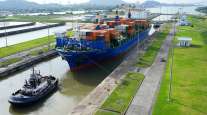Panama Canal Completes 96% of Expansion Project

The Panama Canal Authority has completed 96% of the work on its expansion project, which will more than double the critical waterway’s capacity when it is finished and open to vessels later this year.
The agency in a late December statement outlined the sequence for the steps to finish the project, without naming an opening date. Administrator Jorge Quijano said reinforcement of the ship locks should be finished in the middle of January, followed by testing and the start of trial transit trips in April and the scheduling of an inauguration event in the second quarter.
The canal will accommodate cargo ships carrying up to 13,000 20-foot-equivalent units, or TEUs, using three lanes of waterway instead of the current two. The expansion more than doubles the size of containerships that can be handled, enabling all but the largest vessels on the ocean now to use the 52-mile connection between the Pacific Ocean and the Caribbean Sea.
Panama began the project nearly a decade ago after the Central American nation’s voters approved a referendum authorizing the expansion and a $5.25 billion expenditure to build it. Initially, completion was expected in 2014, the canal’s centennial year, but the date was pushed back after a payment dispute with some contractors.
“We are very close — only 4% remains to complete the project,” Quijano said. “An expansion of the Panama Canal has never been done, and we should all feel very good about where we are today.”
In late December, contractors began to blast away a wall that separates Gatun Lake, in the middle segment of the canal, from a new 4-mile Pacific channel.
“I am very proud of the progress we have made over the past month,” he said. “After a successful year, we look forward to being able to provide the benefits of the new canal to our customers and the people of Panama.”
A commercial opening date will follow soon after the inauguration event, the authority’s announcement said.
“The [authority] is building the expanded canal for the long haul, and quality and testing are critical,” the statement said. Last year, repairs and reinforcement were required after leaks were detected.




